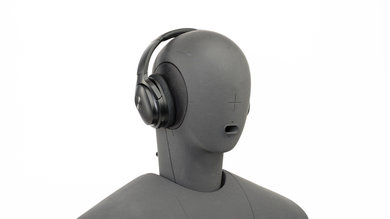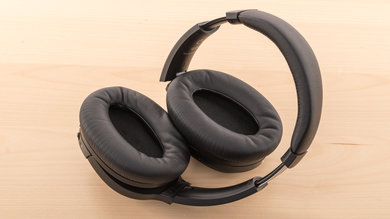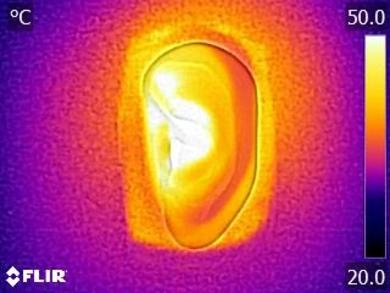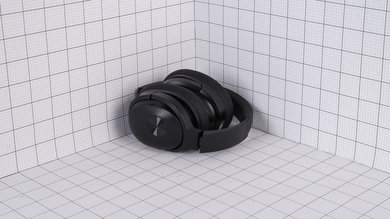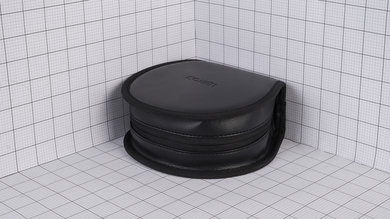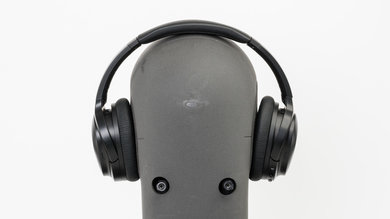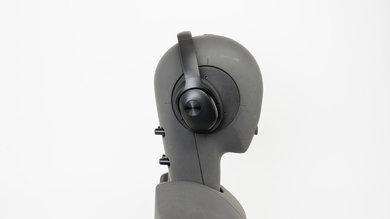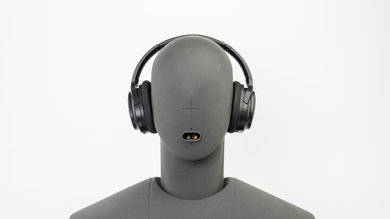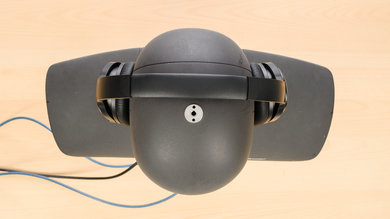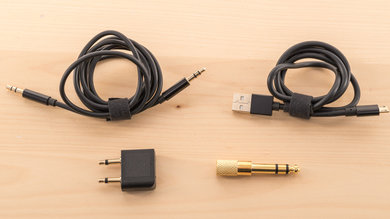The Cowin SE7 Wireless are closed-back headphones with active noise cancelling (ANC). They have a new design that feels more high-end than the Cowin E7 Wireless and the Cowin E7 Pro Wireless. They're also quite a bit more comfortable than these previous models. On the other hand, their audio reproduction is disappointing and feels boomy and cluttered, so they’ll be better suited for bass-heavy genres. Their ANC feature isn’t the best but will do a decent job at isolating out noise, especially if you’re playing audio.
Our Verdict
The Cowin SE7 Wireless are okay for mixed usage. They have a boomy and cluttered sound profile that won’t be ideal for a wide variety of music genres during critical listening. Their ANC feature is quite lackluster, which won’t be ideal for commuting. They're fairly lightweight and stable on the head for sports, but the over-ear design will trap a decent amount of heat. Their decent battery life will last you for a whole workday, but they don’t isolate a lot of ambient chatter, which would have been useful at the office. Also, like most Bluetooth headphones, their latency may be slightly too high for watching videos, and their microphone won’t be great for online gaming.
- Comfortable and durable build.
- Lower latency than average Bluetooth headphones.
- Boomy and cluttered sound profile.
- Sub-par ANC feature.
The Cowin SE7 Wireless are sub-par for neutral listening. They have a boomy bass that lacks thump and rumble, and their mid-range is overemphasized, making the vocals and lead instruments thick and cluttered. Also, their treble is fairly underemphasized, and high frequencies will lack detail and presence. We also noticed a significant drop in bass and overall sound quality when turning the ANC feature on. Overall, these headphones will be better suited for bass-heavy music and won't be ideal for vocal-centric genres. On the upside, they're comfortable to wear for a while.
The Cowin SE7 Wireless are satisfactory for commuting. Their ANC feature isn’t the best, but it blocks an average amount of lower frequency noises like bus engine rumbles. You can also mask more noise when playing audio. Thankfully, they're comfortable, so you can wear these for a while, but they might get hot. Also, their bulky design won’t be very portable, but this shouldn’t be too much of a problem if you wear them around your neck, thanks to the swiveling cups.
The Cowin SE7 Wireless are satisfactory for sports. These headphones are lightweight, and their bass-oriented sound profile can be good for staying pumped during a workout. They apply a good amount of pressure on the head to stay stable, but side movements of the head will make them wiggle off. You can jog with these, but you might sweat more than usual since they trap heat under the ear cups.
The Cowin SE7 Wireless are alright for the office. They block an okay amount of ambient chatter and reduce the noise of A/C systems well. Their battery life will also last you more than a full workday, which is good. Unfortunately, their microphone won’t be ideal for taking business calls. They can’t connect to two devices simultaneously, which would have been useful to switch between your phone and work computer.
The Cowin SE7 Wireless are disappointing for gaming. Their sound profile is boomy and can make video games sound thick. They're decently comfortable for long gaming sessions, but their latency is too high for gaming. They also have a sub-par microphone that won’t be ideal for online gaming with friends and teammates. Even if you don’t need a microphone for single-player games, these headphones won’t be a great choice for this use.
Changelog
- Updated Feb 19, 2020: Converted to Test Bench 1.4.
- Updated Nov 21, 2019: Converted to Test Bench 1.3.1.
- Updated Nov 21, 2019: Converted to Test Bench 1.3.
- Updated Feb 26, 2019: Review published.
Check Price
Popular Headphones Comparisons

The Cowin SE7 are noise cancelling, over-ear headphones that set themselves apart from the previous Cowin headphones by their new, comfortable, and well-built design. However, they have a very boomy and cluttered sound profile, and their ANC feature doesn’t isolate much.
If you’re looking for a pair of headphones to use during your commute, check our recommendations for the best noise cancelling headphones and the best headphones, or if you don’t want to break the bank to get a good product, look at the best headphones under $100.
If a neutral sound profile is the most important thing for you when choosing headphones, then the Cowin E7 Pro Wireless are a better option than the Cowin SE7 Wireless model. They won’t sound as boomy and cluttered, and won’t lack detail in the treble range. However, they might sound too sharp for some. They also have twice the SE7’s battery life. On the other hand, the SE7 are better-built and more comfortable headphones. This new design feels more high-end, doesn’t have a glossy finish that is fingerprint prone, and doesn’t feel flimsy.
The Cowin E8 Wireless are better headphones than the Cowin SE7 Wireless model. They have a more neutral sound profile and won’t sound as boomy and cluttered as the SE7. Their isolation performance is noticeably better, and their ANC does a good job at isolating against low-frequency noises like bus engine rumble. They also have a better battery life. On the other hand, the SE7 leak less and can fold in a more compact format. They also have lower latency and support the aptX codec, which means you won’t notice too much delay when watching video content with these.
The Mpow H5 Wireless are better-sounding headphones than the Cowin SE7 Wireless and can also be connected simultaneously to two devices, which can be useful. Other than that, the two headphones are fairly similar in terms of controls and noise isolation. However, the Cowin seem to be a bit more comfortable, thanks to their soft padding. Their build quality seems a bit more durable, which explains their slightly more expensive price point. If sound is your biggest criteria, get the Mpow, but if durability and comfort are most important, the Cowin would still please most users, especially fans of bass-heavy music.
The Bose QuietComfort 35 II/QC35 II Wireless 2018 are better than the Cowin SE7 Wireless in pretty much every category. The Bose are one of the most comfortable headphones we’ve reviewed so far, their ANC feature blocks an impressive amount of ambient noise, and they have a very well-balanced sound profile. They have longer battery life and will be a more versatile pair of headphones than the Cowins. The Cowin have noticeably lower latency and are quite a bit cheaper than the Bose.
Test Results

The Cowin SE7 have a more polished and high-end look than the Cowin E7 Wireless and Cowin E7 Pro Wireless. The cups have a matte coating and don’t have the same glossy finish and cheap plastic feel as the older models. They're also less bulky and don’t have the same circular design. They have a small metal circle for style on each cup, but other than that, they're fairly low-profile. It seems Cowin went for a design that resembles the Bose Bose QuietComfort 35 II/QC35 II Wireless 2018 a bit. The SE7 come in different colors to suit your style: black, gold, purple, or dark green.
The new Cowin SE7 design is more comfortable than previous models like the Cowin E7 Wireless. The cups and headband are well-padded and soft. These headphones are lightweight and don’t put too much pressure on your head, but still feel stable. However, the ear cups might be small and uncomfortable for some people, especially if you have bigger ears. Nevertheless, most users should be able to wear these for a while before feeling ear soreness.
The Cowin SE7's control scheme is decent, but it has certain flaws. The physical buttons are very clicky and offer good feedback, but they aren’t the easiest to use. You get common functionalities like calling, music, and volume control, which is expected. You can also skip tracks, but the controls are inverted from what you usually see on headphones, meaning that holding volume down will skip tracks forward instead of backward. Also, you have to hold their power button for several seconds to power them on. On the upside, you have a separate switch for enabling and disabling ANC. However, you need to remember to switch both the ANC and the headphones off, or it drains your battery.
Like most closed-back over-ears, the Cowin SE7 aren’t very breathable by design. They trap a decent amount of heat under the cups, which will make a noticeable difference in the ear temperature over time. Also, there is a warning in the manual that reminds you to take these off every 1-2 hours in the summer heat. These headphones can make you sweat more than usual and won’t be ideal for working out.
Like most over-ears, the SE7 are not very portable headphones. They have a bulky design, but thankfully the cups swivel to lay flat, making them easier to slide in a bag. They also fold into a more compact format, and you can put these in their soft case, which doesn’t add too much bulk.
The Cowin SE7 come with a soft case. This protects the headphones from minor water exposure and scratches but won’t do much against significant impacts. It's slightly disappointing when compared to the Cowin E7 Pro Wireless' hard case, but it's better than the original Cowin E7 Wireless' case.
The Cowin SE7 have a better build quality than other Cowin headphones. They don’t have the same glossy finish and flimsy plastic design that of the Cowin E7 Wireless. The SE7 cups feel dense and solid enough to survive a few accidental drops without too much damage. The headband is reinforced with a thin metal sheet and is still flexible enough.
These over-ears are decently stable. They fit nicely on your head and apply enough pressure to stay in place, even when shaking your head. Their lightweight design doesn’t make them slide off when tilting your head forward or backward and should be stable enough for running. They're also wireless, which means you don’t have to worry about the headphones getting yanked off because the cable got hooked on something.
The Cowin SE7's frequency response is decently consistent. In the bass range, the maximum deviation measured across our five human subjects is about 3dB, which is subtle but noticeable. In the treble range, up to 10kHz, the maximum deviation measured across five re-seats was about 12dB, but mostly in a narrow range around 5kHz.
The Cowin SE7 have sub-par bass performance. The underemphasis in the low-bass means that they lack thump and rumble. Mid-bass, responsible for the body of bass guitars and the punch of kick drums is also underemphasized, so mixes lose punch and body. However, the high-bass, which is responsible for warmth, is overemphasized, adding excess muddiness to the overall sound. We also noticed a significant drop in bass when using the ANC feature.
The Cowin SE7's mid accuracy is great. Low-mid is overemphasized and is the continuation of the high-bass bump. This overemphasis makes vocals and lead instruments sound thick and cluttered. However, the mid-mid is fairly flat and neutral, so vocals and lead instruments are present. However, a dip in the high-mid can weaken the upper harmonics of these sounds.
The Cowin SE7's treble accuracy is bad. The whole range is noticeably underemphasized. This has a negative effect on the detail and brightness of sibilances (S and T sounds). This will be most noticeable on vocals, lead instruments, and cymbals.
The imaging is excellent. The weighted group delay is at 0.21, which is very low. The GD graph also shows the group delay response is almost entirely below the audibility threshold, suggesting a tight bass reproduction and a transparent treble. The jumps in group delay in low-bass won’t be very audible since they fall below the LFE of the headphones. Additionally, the L/R drivers of our test unit were well-matched in amplitude, frequency, and phase response, which is important for the accurate placement and localization of objects (voices, instruments, video game effects) in the stereo image. However, these results are only valid for our unit, and yours may perform differently.
The Cowin SE7's soundstage is poor. The graph suggests good pinna interaction/activation, but mediocre in distance and accuracy. So the soundstage may be perceived as unnatural and located inside the listener's head. Also, due to the closed-back design and active noise cancelation, their soundstage won't feel as open and spacious as open-back headphones.
The Cowin SE7 have an acceptable noise isolation performance, which is disappointing for ANC headphones. In the bass range, where the rumble of airplane and bus engines sits, they isolate by about 8dB, which is average. In the mid-range, important for blocking out speech, they achieved about 11dB of isolation, which is poor. In the treble range, occupied by sharp sounds like S and Ts, they reduce outside noise by about 32dB, which is excellent.
The Cowin SE7's leakage performance is great. The significant portion of leakage sits between 1kHz and 6kHz, which is a relatively narrow range. This results in a leakage that sounds fuller and more comprehensible than the leakage of in-ears and earbuds, but not as much as open-back headphones. However, the overall level of leakage is not too loud. With the music at 100dB SPL, the leakage at 1 foot away averages at 33dB SPL and peaks at 47dB SPL, which is just under the noise floor of most offices.
The Cowin SE7's integrated microphone has a disappointing performance. LFE (low-frequency extension) is at 220Hz, indicating that speech recorded/transmitted with this mic sounds relatively thin. The HFE (high-frequency extension) of 3kHz results in speech that's noticeably muffled and lacking in detail. However, the recorded/transmitted speech would still be reasonably comprehensible in quiet environments, since that is mostly dependent on the 500Hz-3kHz range.
The noise handling of the Cowin SE7's mic is sub-par. In our noise handling test, they achieved a speech-to-noise ratio of 9dB, which means they're mostly suitable for quiet environments and struggle to separate speech from background noise even in moderately loud environments.
We’ve measured a 15-hour battery life, which is considerably lower than the advertised 22 hours (there is also mention of a 30-hour battery life, but we couldn’t figure out which number was the ‘real’ advertised battery life). According to the specs sheet, they can last up to 720 hours when they enter their standby mode. Also, you can use them with the included audio cable, even if the battery is dead. You can use the ANC feature when wired if there’s battery life left too.
These headphones don’t have an app with customization options.
Although we tested these headphones using Bluetooth 4.2, they support Bluetooth version 5.0, so you might get better wireless range and connection stability than what we’ve measured if you use this version. Unfortunately, they can’t connect to multiple devices simultaneously and don’t have NFC for quick pairing. However, their pairing procedure is simple, and we didn’t experience any issues.
The Cowin SE7's latency is better than most Bluetooth headphones that usually average around 200-220ms of delay. This means some people may not notice the delay as much. Also, they support aptX, which gives you even lower latency if your source supports it. This should still be too high for gaming, but you might not notice the delay as much when watching video content, especially that some devices and apps offer some sort of compensation.
The Cowin SE7 don’t have a base or a dock. If you’re interested in versatile headphones with one, we suggest looking at the SteelSeries Arctis 7 Wireless 2017.

